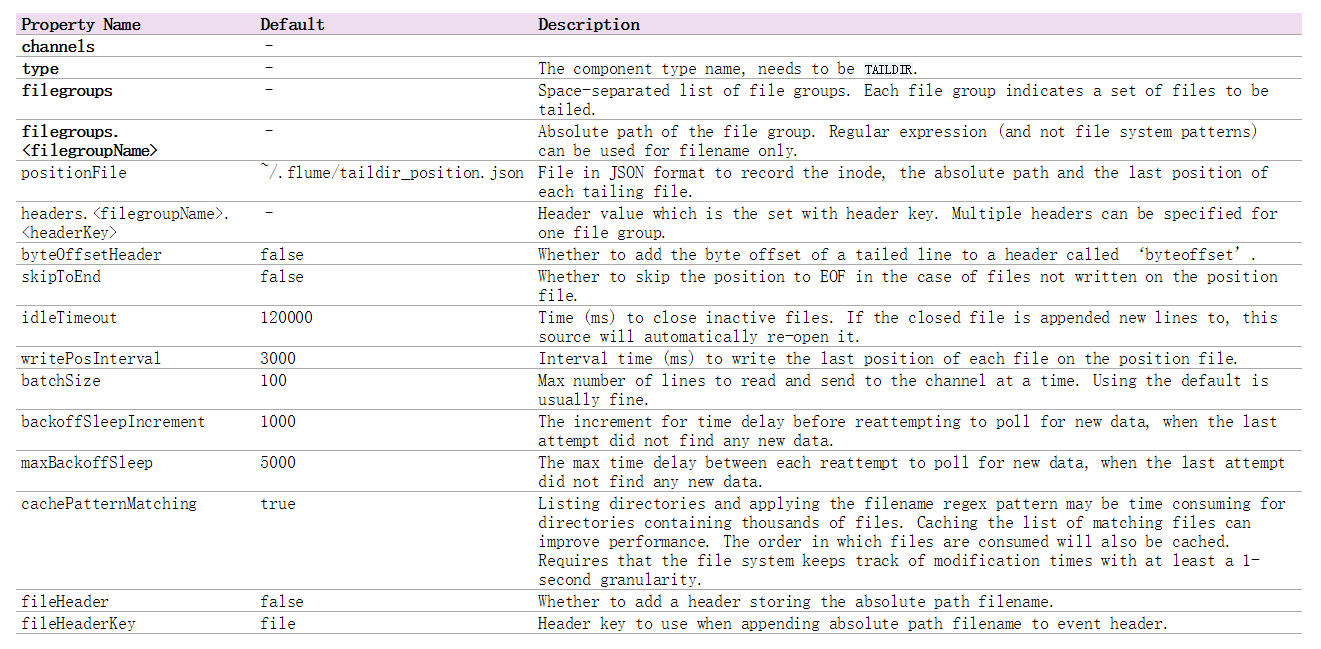您好,登錄后才能下訂單哦!
您好,登錄后才能下訂單哦!
小編給大家分享一下flume1.7 新特性是什么,相信大部分人都還不怎么了解,因此分享這篇文章給大家參考一下,希望大家閱讀完這篇文章后大有收獲,下面讓我們一起去了解一下吧!
在flume1.7之前如果想要監控一個文件新增的內容,我們一般采用的source 為 exec tail ,但是這會有一個弊端,就是當你的服務器宕機重啟后,此時數據讀取還是從頭開始,這顯然不是我們想看到的! 在flume1.7沒有出來之前我們一般的解決思路為:當讀取一條記錄后,就把當前的記錄的行號記錄到一個文件中,宕機重啟時,我們可以先從文件中獲取到最后一次讀取文件的行數,然后繼續監控讀取下去。保證數據不丟失、不重復。
具體配置文件修改為:
a1.sources.r3.command = tail -n +$(tail -n1 /root/nnn) -F /root/data/web.log | awk 'ARGIND==1{i=$0;next}{i++;if($0~/^tail/){i=0};print $0;print i >> "/root/nnn";fflush("")}' /root/nnn -
其中/root/data/web.log 為監控的文件,/root/nnn為保存讀取記錄的文件。
而在flume1.7時新增了一個source 的類型為taildir,它可以監控一個目錄下的多個文件,并且實現了實時讀取記錄保存的功能!功能更加強大! 先看看官網的介紹:
-Taildir Source
Note
This source is provided as a preview feature. It does not work on Windows.
Watch the specified files, and tail them in nearly real-time once detected new lines appended to the each files. If the new lines are being written, this source will retry reading them in wait for the completion of the write.
This source is reliable and will not miss data even when the tailing files rotate. It periodically writes the last read position of each files on the given position file in JSON format. If Flume is stopped or down for some reason, it can restart tailing from the position written on the existing position file.
In other use case, this source can also start tailing from the arbitrary position for each files using the given position file. When there is no position file on the specified path, it will start tailing from the first line of each files by default.
Files will be consumed in order of their modification time. File with the oldest modification time will be consumed first.
This source does not rename or delete or do any modifications to the file being tailed. Currently this source does not support tailing binary files. It reads text files line by line.

需求:實現flume監控一個目錄下的多個文件內容,實時的收集存儲到hadoop集群中。
配置案例:
a1.channels = ch2
a1.sources = s1
a1.sinks = hdfs-sink1
#channel
a1.channels.ch2.type = memory
a1.channels.ch2.capacity=100000
a1.channels.ch2.transactionCapacity=50000
#source
a1.sources.s1.channels = ch2
#監控一個目錄下的多個文件新增的內容
a1.sources.s1.type = taildir
#通過 json 格式存下每個文件消費的偏移量,避免從頭消費
a1.sources.s1.positionFile = /var/local/apache-flume-1.7.0-bin/taildir_position.json
a1.sources.s1.filegroups = f1 f2 f3
a1.sources.s1.filegroups.f1 = /root/data/access.log
a1.sources.s1.filegroups.f2 = /root/data/nginx.log
a1.sources.s1.filegroups.f3 = /root/data/web.log
a1.sources.s1.headers.f1.headerKey = access
a1.sources.s1.headers.f2.headerKey = nginx
a1.sources.s1.headers.f3.headerKey = web
a1.sources.s1.fileHeader = true
##sink
a1.sinks.hdfs-sink1.channel = ch2
a1.sinks.hdfs-sink1.type = hdfs
a1.sinks.hdfs-sink1.hdfs.path =hdfs://master:9000/demo/data
a1.sinks.hdfs-sink1.hdfs.filePrefix = event_data
a1.sinks.hdfs-sink1.hdfs.fileSuffix = .log
a1.sinks.hdfs-sink1.hdfs.rollSize = 10485760
a1.sinks.hdfs-sink1.hdfs.rollInterval =20
a1.sinks.hdfs-sink1.hdfs.rollCount = 0
a1.sinks.hdfs-sink1.hdfs.batchSize = 1500
a1.sinks.hdfs-sink1.hdfs.round = true
a1.sinks.hdfs-sink1.hdfs.roundUnit = minute
a1.sinks.hdfs-sink1.hdfs.threadsPoolSize = 25
a1.sinks.hdfs-sink1.hdfs.useLocalTimeStamp = true
a1.sinks.hdfs-sink1.hdfs.minBlockReplicas = 1
a1.sinks.hdfs-sink1.hdfs.fileType =DataStream
a1.sinks.hdfs-sink1.hdfs.writeFormat = Text
a1.sinks.hdfs-sink1.hdfs.callTimeout = 60000
以上是“flume1.7 新特性是什么”這篇文章的所有內容,感謝各位的閱讀!相信大家都有了一定的了解,希望分享的內容對大家有所幫助,如果還想學習更多知識,歡迎關注億速云行業資訊頻道!
免責聲明:本站發布的內容(圖片、視頻和文字)以原創、轉載和分享為主,文章觀點不代表本網站立場,如果涉及侵權請聯系站長郵箱:is@yisu.com進行舉報,并提供相關證據,一經查實,將立刻刪除涉嫌侵權內容。